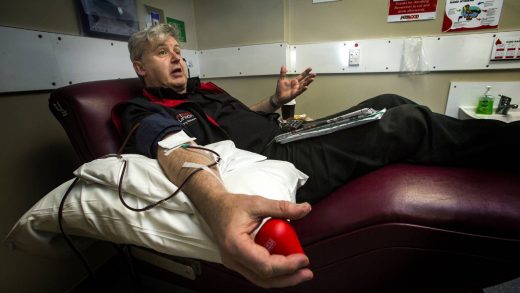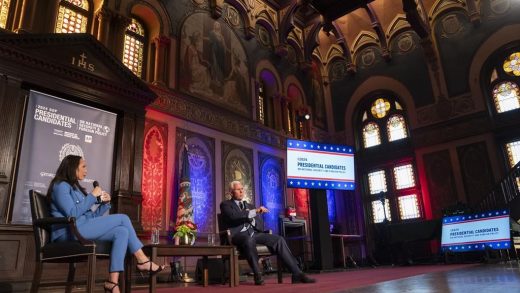
They gathered, they marched, and they made themselves heard.
Thousands of protesters of all ages, led by youth organisations School Strike for Climate and Fridays for Future, took to the streets in 11 centres across the country on Friday, demanding action from leaders on climate change.
Christchurch climate strikers marched from Cathedral Square and occupied the city council headquarters for several hours, specifically demanding the Tarras airport plan be abandoned – and giving Mayor Phil Mauger a drubbing for saying he’d changed his position on climate change “after the events that have happened up north”, referring to the devastation wreaked by Cyclone Gabrielle.
In Wellington, a large crowd gathered in Civic Square before marching to Parliament, where they heckled National’s Remutaka candidate Emma Chatterton during her speech.
In Auckland, unplanned road closures due to the protest caused rush hour traffic madness. Students and supporters were meant to march from Britomart to Aotea Square via Queen St, but decided instead to march along Fanshawe St towards Victoria Park to protest outside Fonterra and Air New Zealand offices.
READ MORE:
* In defence of climate protest
* ‘Keep your carbon in the soil’: Students strike again against climate change
* Christchurch climate strike organisers ‘hopeful’ after meeting with mayor
KAI SCHWOERER/Stuff
Christchurch mayor Phil Mauger talks with protesters, who occupied the city council headquarters for several hours.
The five key demands of strikers across the country was an end to mining exploration, lowering the voting age to 16, doubling marine reserves by 2025, establishing and implementing a regenerative farming transition fund, and e-bike rebates for lower income households.
Christchurch Airport’s plan to build an international airport at Tarras was the key issue for strikers in the Garden City, who pointed to the council’s declaration of a climate emergency in 2019.
Council-owned company Christchurch City Holdings Ltd owns 75% of Christchurch Airport, while the Crown owns the remainder.
Juan Zarama Perini/Stuff
“Last exit before doomsday,” one sign reads during climate strike action in Wellington.
Mauger, who’d had a “prior engagement” at the Isaac Theatre Royal during the climate strike, later responded to requests to front the gathering, and arrived about 40 minutes after the occupation began.
The mayor, describing himself as a “hydrogen nut”, said he thought hydrogen technology “could well be” far enough advanced by the time the Tarras airport happened to lessen the carbon impact of additional flights.
Mauger acknowledged he was not aware of the protesters’ demands, but said he did not agree with the push to lower the voting age.
KAI SCHWOERER/Stuff
Climate strikers marched from Cathedral Square to the Christchurch city council building.
“I don’t agree with the 16 years, I’m very sorry. There’s some of you that are extremely well-educated and do need to be able to vote, but there’s some that aren’t,” he said.
“What percentage of 16 and 17-year-olds would vote if they were given the vote, do you think?”
In 2020, the Christchurch City Council threw its weight behind the campaign to lower the voting age. Last month, the council reiterated its support, though Mauger did not personally agree.
Hamish McNeilly/Stuff
Hundreds of people were at the climate strike in Dunedin’s Octagon on Friday afternoon.
Mauger also told the protesters he was concerned about the cost of the city’s cycleways.
“I’m not against cycleways, just get that very clear in your head, I’m totally against how much we’re spending on doing them.”
Activists, who booed many of Mauger’s comments, reminded him of his view in 2022 as a city councillor that he wanted money diverted from cycleways to the city’s new stadium.
KAI SCHWOERER/Stuff
Sunny Radzyner, 17, leaves a message at the Christchurch City Council headquaters during the School Strike for Climate rally.
Several city councillors were in attendance, including Mark Peters, Tyla Harrison-Hunt, Sara Templeton and Celeste Donovan.
The global School Strike movement was borne out of a protest outside the Swedish parliament by climate activist Greta Thunberg in 2018, although students in different parts of the world had been walking away from classes to demand action for at least a decade prior.
In an interview on RNZ on Friday morning, School Strike For Climate Christchurch spokesperson Aurora Garner-Randolph, 17, said organisers had expected a turnout of 15,000 to 20,000 across the country’s main centres.
Napier kicked the strike off at 11am on Friday. New Plymouth began at noon, Wellington at 2pm, and Kaitaia just before 3pm, before the mass exodus about 3pm in Auckland, Christchurch, Dunedin, Palmerston North, Nelson, Queenstown, Waiheke Island, Tauranga and Wānaka.
Mildred Armah/Stuff
Hundreds gather in downtown Auckland to march for climate justice.
Garner-Randolph said young people deserved a say in who and how the existential challenges posed by climate change were tackled.
“It’s our generation that’s going to have to deal with the effects from extreme weather events, so we have a real vested interest in being able to say how our Government acts now.”
She believed doubling marine reserves before 2025 was urgent and necessary, and only sounded ambitious “because our current legislation is so far out of line with what is recommended internationally by scientists – 30% is the minimum marine protection that’s recommended, some say 40% or 50% is an ideal goal.”
An extension of the electric car rebate to electric bikes could create a real shift in the approach to transport, she said.
Garner-Randolph acknowledged the importance of farming, but noted a large proportion of New Zealand’s emissions came from intensive farming.
Keiller MacDuff/Stuff
Tobin Moggre, 5, Sanne Moggre, 3, and mum Alicia Moggre at the Christchurch school climate strike.
“We want to work with farmers, not against them, to transition to less intensive farming methods.
She dismissed the tendency to absolve New Zealand from emission reductions based on our relative size.
“Although we may be small, we are huge per capita emitters, and that needs to change.”
John Cowpland/Stuff
Napier students protest at the Soundshell in a national day of climate activism by schoolchildren.
The first New Zealand strike, on March 15, 2019, was overshadowed by the Christchurch terror attack.
But by the time the third strike happened in September that year, it became one of the largest protests in New Zealand’s history, numbering some 170,000 marchers around the country, and one of the highest per capita turnouts of any major country.
Then came Covid-19. Strikes were held sporadically and in lower numbers, but this year’s – released from Covid restrictions – happened in the wake of disastrous severe weather events in large swathes of the north.
KAI SCHWOERER/Stuff
A sign saying “Our planet is hotter than Taylor Swift” is seen during the School Strike for Climate rally in Christchurch.


